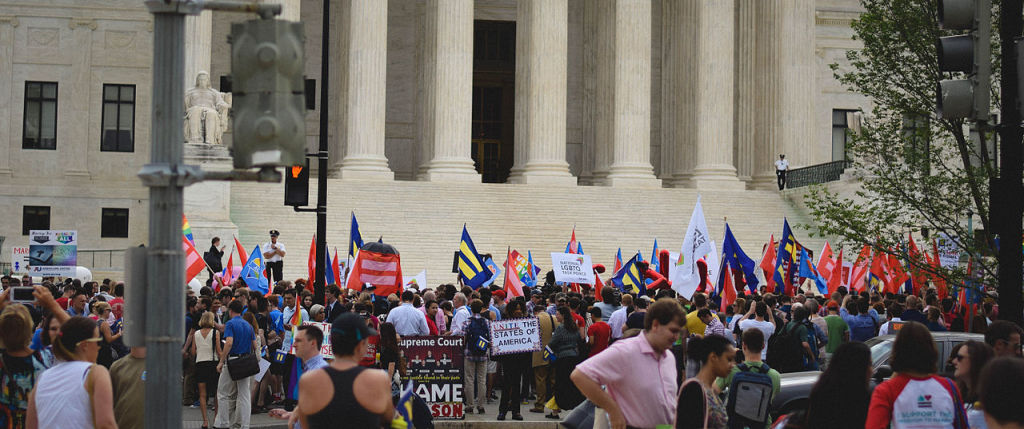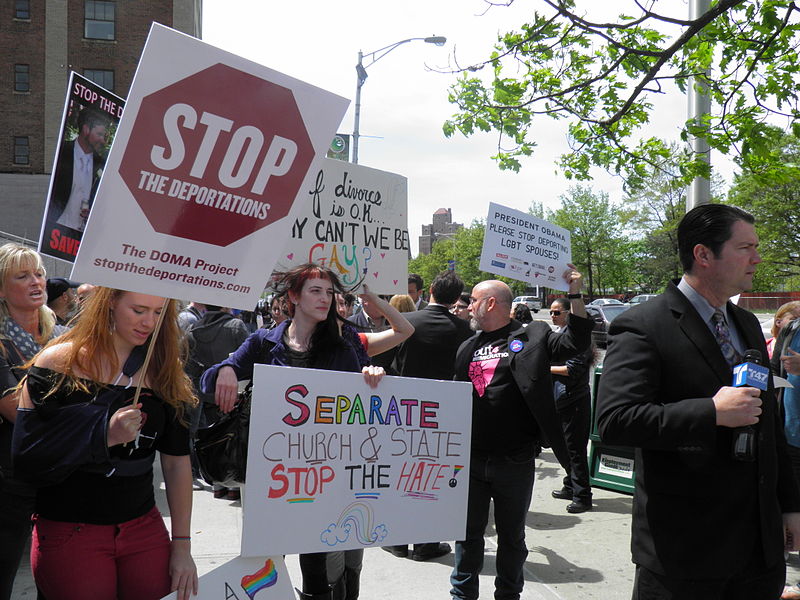
Last month, members of the LGBT community extolled the Supreme Court decision in Obergefell v. Hodges that legalized same-sex marriage across the country. The day was undeniably historic and will be remembered as a necessary benchmark in the march toward equality. Immigration advocates welcomed the decision as a victory for marginalized people, one that would make the country more equitable for everyone.
While Obergefell made it unconstitutional for states to ban same-sex marriage, the issue had only been one that primarily concerned the states for two years. The Supreme Court decision in June 2013 made same-sex marriage an issue of state law: Windsor v. United States declared unconstitutional Section 3 of the Defense of Marriage Act (DOMA) – the federal law that defined marriage as a union between a man and a woman. Once DOMA was struck down, United States Citizenship and Immigration Services (USCIS) announced that it would henceforth begin recognizing immigrant visa petitions filed by U.S. citizens in same-sex marriages for their alien spouses, provided that the marriage took place in jurisdictions where the union was considered legal. Until the Obergefell decision, this included just 37 states, Guam and the District of Columbia.
The Windsor decision only went so far as to make federal benefits related to marriage obtainable in states where same-sex marriages were recognized. Since immigration law is a federal issue, this meant that same-sex spouses were only able to obtain family-based immigration visas (green cards) if they got married in one of those states. Obergefell took this one step further, and now federal law allows U.S. citizens in any state to petition for their same-sex spouses. To prohibit this equality is now considered unconstitutional.
After the Obergefell decision, however, the celebration eventually ended. The streamers fell from the sky and were swept away, and the “Love Wins” signs recycled. The day left many asking: “What’s next?” After all, marriage equality had been the Holy Grail for the modern LGBT movement, and on June 26, it was achieved.
For many the battle has only just begun. As the Oakland-based Transgender Law Center put it, “Our priorities remain unchanged by the [Obergefell] marriage ruling: We are working toward a future where all people can live safely, authentically, and free from discrimination regardless of gender identity or expression.’”
There are still a multitude of inequalities facing LGBT people, especially those who are also undocumented immigrants. United We Dream (UWD), a youth-led U.S. immigration organization, called the ruling bittersweet, explaining that undocumented LGBT individuals face discrimination on two fronts, for both sexual and gender identity as well as their immigration status. Moreover, LGBT immigrants face high rates of violence and sexual assault in immigrant detention centers; 1 in 500 detainees are transgender, for example, but 1 in 5 substantiated cases of sexual assaults reported in detention centers are reported by transgendered women.

When we think “identity discrimination,” our minds typically jump to identities related to gender or sexuality. But how do we protect those whose sources of identity discrimination are their legal statuses? Undocumented immigrants often describe living in fear that their legal status may be discovered as “living in the shadows;” semantic parallels between this and the “living in the closet” language used by the LGBT community are easily drawn. This shame, both for the undocumented and for many LGBT individuals, comes from the societal norm, ensconced in discriminatory policies, that those who possess such identities are less valued in society, or worse, that society would be better off without their inclusion.
Opponents of immigration reform could point to distinctions in the definitions of the “identities” of undocumented immigrants and LGBT individuals. After all, the identities of LGBT individuals are inherent and not choice-based, and relocation involves an active decision-making process. However, migrants and refugees are often forced into “undocumented” identities by violence, persecution, or a lack of opportunities. And while the idiosyncrasies of the discrimination against each differs in origin, the message of many opponents of either (or both) remains clear: you are polluting my idea of America, and I don’t like it.
So, as bills are passed promoting LGBT rights and Supreme Court rulings in favor of marriage equality come down, more and more barriers barring the closet door are removed. So it must go for the undocumented immigrants living in the shadows.
Their sources of shame are pathways to citizenship accessible only to the wealthy. Their sources of shame are the criminalization of immigrants in removal proceedings and the unnecessary detention of low-priority immigrants, including families and children. Their sources of shame are, that even after decades of productivity in the American economy, and membership in local communities, they are deemed unwelcome because of their country of origin, or their parents’ decision to enter into the United States unlawfully.
Comprehensive immigration reform, the overhaul of detention policies, and the demilitarization of border patrol are policy changes that can pull people out of the shadows, and allow them, to harken back to the Transgender Law Center, to live their lives safely, authentically, and free of discrimination.
